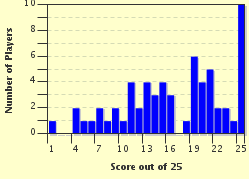Quiz Answer Key and Fun Facts
1. Who am I? I was a medium-sized Tyrannosaur. I lived in Mongolia during the Maastrichtian stage of the late Cretaceous period and my name means "Different branch".
2. Who am I? Perhaps the most famous dinosaur, I lived in Canada and the USA during the Maastrichtian stage of the late Cretaceous period. One of the largest known land predators, my name means "Tyrant lizard king".
3. Who am I? My name means "Southern lizard". I was a Sauropod dinosaur and I lived in South America during the Campanian and Maastrichtian stages of the late Cretaceous period.
4. I was a Sauropod dinosaur with an unusual feature: I had spikes and armour plating on my back. My name means "Vineyard lizard" and I lived in France during the Maastrichtian stage of the late Cretaceous period. Who am I?
5. My long and rather complicated name means "Posterior cavity tail". I was a Sauropod dinosaur and I lived in Mongolia during the Campanian and Maastrichtian stages of the late Cretaceous period. Who am I?
6. I lived in Spain and France during the Maastrichtian stage of the late Cretaceous period. I was a Sauropod dinosaur with a name meaning "Highest lizard". Who am I?
7. Who am I? My name means "Heavy lizard". I lived in South America during the Maastrichtian stage of the late Cretaceous period and I was a Sauropod dinosaur.
8. Who am I? I was a small Ornithopod dinosaur with a name meaning "Mountain runner". I lived in the USA during the Campanian stage of the late Cretaceous period.
9. Who am I? My name means "Marsh lizard". I lived in Spain, France and Romania during the Maastrichtian stage of the late Cretaceous period and I was a medium-sized Hadrosaur.
10. I was a large Hadrosaur. I lived in China during the Campanian and Maastrichtian stages of the late Cretaceous period and my name means "Manchurian lizard". Who am I?
11. Who am I? I was one of the largest Hadrosaurs. I lived in China during the Maastrichtian stage of the late Cretaceous period and I'm named after a figure in Greek mythology.
12. I lived in Russia during the Maastrichtian stage of the late Cretaceous period. My name means "Giant swan" and I was a large Hadrosaur with a spectacular head crest. Who am I?
13. Who am I? I was a large Hadrosaur and I lived in Russia during the Maastrichtian stage of the late Cretaceous period. I was named after a mythological dog.
14. Who am I? My name means "Good Mother lizard" as there is evidence that I fed and cared for my young until they were old enough to fend for themselves. I lived in the USA during the Campanian stage of the late Cretaceous period.
15. Who am I? I was one of the largest flat-headed Hadrosaurs. My name means "Giant duck" and I lived in the USA during the Maastrichtian stage of the late Cretaceous period.
16. I was a tiny Ornithopod dinosaur with the distinction of having the longest dinosaur name on record. I lived in China during the Campanian stage of the late Cretaceous period. Who am I?
17. My name means "Swollen head". I lived in Mongolia during the Campanian stage of the late Cretaceous period and I was a small Pachycephalosaur. Who am I?
18. I lived in the USA during the Campanian and Maastrichtian stages of the late Cretaceous period. I was a small Pachycephalosaur with a name meaning "Spherical dome". Who am I?
19. Who am I? I was a small primitive short-frilled Ceratopsian. My name means "First horned face" and I lived in China and Mongolia during the Santonian and Campanian stages of the late Cretaceous period.
20. Who am I? My name means "Turanian horned face". I was a small primitive short-frilled Ceratopsian and I lived in Kazakstan during the Cenomanian and Turonian stages of the late Cretaceous period.
21. Who am I? I lived in the USA during the Campanian stage of the late Cretaceous period. I was a medium-sized short-frilled Ceratopsian with a name meaning "Ava's horned face".
22. I was a large short-frilled Ceratopsian with a massive lump of bone on my nose. My name means "Thick-nosed lizard" and I lived in Alaska and Canada during the Maastrichtian stage of the late Cretaceous period. Who am I?
23. I lived in Canada and the USA during the Maastrichtian stage of the late Cretaceous period. I was a large long-frilled Ceratopsian with a name meaning "Chasm lizard". Who am I?
24. The largest of the Ceratopsians, I'm one of the most famous and easily-recognised dinosaurs. I lived in Canada and the USA during the Maastrichtian stage of the late Cretaceous period and my name means "Three horned face". Who am I?
25. Who am I? I was a large primitive Ankylosaur. My name means "Roof shield" and I lived in the USA from the Albian stage of the early Cretaceous to the Cenomanian stage of the late Cretaceous period.
Source: Author
ElusiveDream
This quiz was reviewed by FunTrivia editor
WesleyCrusher before going online.
Any errors found in FunTrivia content are routinely corrected through our feedback system.


